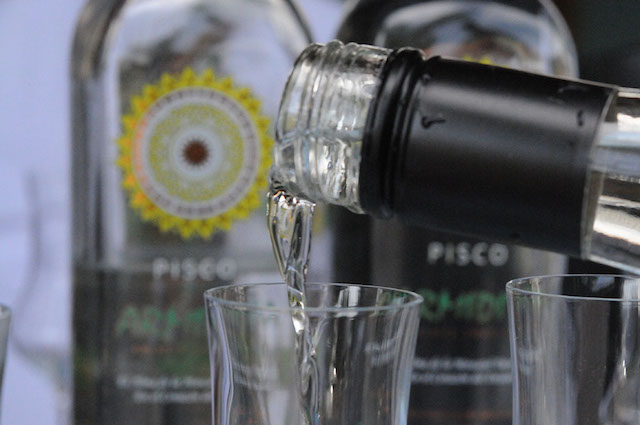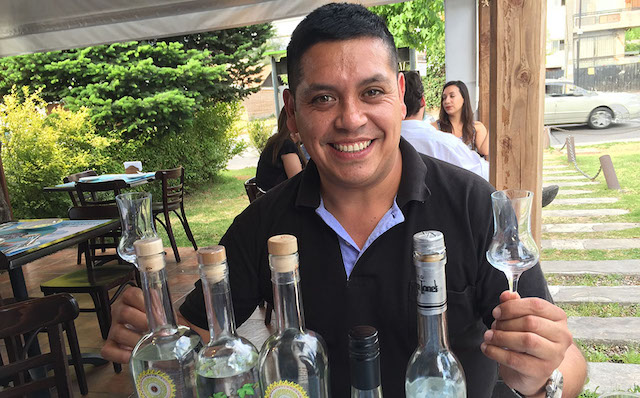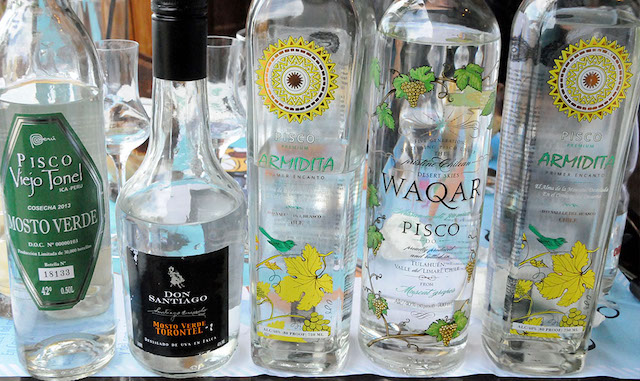Ask a Chilean or Peruvian about pisco, and you’re sure to get an earful. While it’s considered the national spirit of both countries, what’s sold as pisco in Peru cannot be sold as such in Chile, and vice versa. If the Peruvian brew makes its way to Chile, it comes labeled as the significantly less impressive “distilled grape alcohol” (aguardiente or destilado de uva) because Peru does not meet the denominación de origen requirements in Chile. On the other hand, if you could even get Chilean pisco in Peru (unlikely — it’s illegal to import), the process by which it’s made wouldn’t fit the strict requirements Peru has about its production.
Basically, both Chile and Peru have a strict trifecta of regulations, which only occasionally overlap. I began to understand these rules after an interview with Felipe Avendaño, who studied to be a sommelier in Chile and a pisco catador (taster) in Peru. So, I asked Avendaño to give me an unbiased look at the different where-what-how for both Chile and Peru, and guide me through how those products express those origins and processes in the glass.
To me, as to many consumers of pisco, the most familiar form of consumption is the pisco sour, a tangy combination of pisco, lemon juice, powdered sugar and sometimes egg whites and bitters. But encouraging people to drink pisco on its own is one of Avendaño’s main motivators, and to teach me about it, he’s brought a selection of piscos from his personal collection, each representing different valleys and styles in Peru and Chile.
First, Avendaño gives me a run down about the main differences between Peruvian and Chilean piscos. Each country has specific regions and grapes, which, if processed properly, can become pisco. The regions in Peru are in valleys from the middle to the south, and in Chile from the extreme north to the mid-north. Each country restricts the varieties of grapes that can be used, with eight in Peru meeting muster, and a theoretical 13 in Chile (though only five are currently used).
From here, the waters start to muddy. The grape varieties overlap from Chile to Peru, but use different nomenclature. While moscatel is considered a single variety in Peru, three different kinds of moscatel are classified as different varieties in Chile.
Of course, as with wine, using the same varieties of grapes does not ensure similar products. Results can differ with climate: Chileans grow grapes in a desert with extremely low humidity, while Peruvian grapes are grown closer to the ocean in higher humidity. The vines are also watered differently, with Chile using drip irrigation, and flood irrigation being more common in Peru.
Terroir, growing conditions and grape varieties all affect the final product, but another important element of pisco is its method of production. Peru and Chile have different regulations about that, too.
The two piscos are distilled using different types of stills, which affects the taste of the final product. Lady Ramirez, who makes pisco at the family-run Armidita in the Atacama desert, says the different shape of the condensers used in pisco stills changes the amount of aromas and polyphenols concentrated into the pisco.
In addition, in Chile, pisco can be distilled as many times as the pisco maker deems appropriate. Multiple distillation makes for a “purer” product, but Avendaño warns that repeated distilling strips out aroma and flavor (and he and Ramirez agree that one mass-market Chilean brand, which is distilled three times, is likely looking to capture the vodka-drinking crowd). The multiple distillations of pisco raise the alcohol content, which Chilean distillers can then lower with the addition of water. This is neither necessary nor permitted in Peru, where it must be bottled straight out of the still.
So far, it’s clear that Peruvian and Chilean piscos are not the same. They don’t share a “where,” they don’t really share a “what” (type of grape), and the “how” (distilling differences) adds even more complexity.
 The differences between Peruvian and Chilean piscos are vast, but to truly grasp what sets one apart from the other, you have to taste them. Photos by Eileen Smith.
The differences between Peruvian and Chilean piscos are vast, but to truly grasp what sets one apart from the other, you have to taste them. Photos by Eileen Smith.
But how do these where-what-how differences actually affect the flavor of pisco?
We finally sit down to start tasting, starting with a Viejo Tonel Mosto Verde Peruvian pisco made from quebranta grapes in the Ica valley. Avendaño instructs that the first taste is more of a kiss, meaning just barely wetting your mouth. It has fruity flavors, some banana, some apple, and a toasty flavor that Avendaño suggests is reminiscent of straw, or toasted pecans.
Next is Don Santiago Mosto Verde from Queirolo, Peru, made from torontel grapes. Instead of being fruity like the quebranta, it’s floral, with notes of jasmine and orange blossom, and leaning towards lemongrass. It’s creamier than the quebranta, seems to cover my mouth more, and lasts longer — an effect of the complex tannins in the grape.
The first Chilean pisco we try is Armidita’s 2014 double-distilled pisco. It’s less aggressive than the Peruvian piscos we tried, but perhaps not as aromatic.
We move on to Waqar, another small-production pisco made in the Limarí valley of Chile, much further south than Armidita. Our experts pronounce it citrusy.
After their 400-bottle run of the 2014, Armidita said goodbye to making mild-flavored piscos, and changed their formula and processes to emphasize the distinctiveness of the grapes in their valley. The result is the Armidita 2015, which we’re about to try. “This one respects the distinctiveness of the moscatel of Alexandria grape,” says Ramirez. At first, it’s citric in the mouth, turns creamy, and ends with vanilla. Avendaño picks up a note of sweet anise in the aftertaste.
I’m left wondering how the 2014 and 2015 piscos can be so different. The where has stayed the same, and the what only changed slightly. It seems the difference is mainly about the how.
Armidita does a very short distillation, and very little of what is distilled is considered the “heart,” or the very best part of the pisco, which will be bottled and sold. In 2015, Armidita upped the quantity of moscatel of alexandria grapes to be fermented, and, they also did a blend of their own pisco, with 60% of it distilled once, and 40% distilled twice. The resulting pisco was 86 proof, and they cut it with water from glacial melt, the extremely low temperature of which, Ramirez tells me, concentrates aromatic flavors even more.
 Felipe Avendaño, who studied to be a sommelier in Chile and a pisco “catador” (taster) in Peru, led us through a comparative tasting of piscos from both countries to highlight the striking differences between the two.
Felipe Avendaño, who studied to be a sommelier in Chile and a pisco “catador” (taster) in Peru, led us through a comparative tasting of piscos from both countries to highlight the striking differences between the two.
In Chile, Peruvian pisco is very popular, and with good reason, Ramirez says. “They do what they do, and they do it well. But the average Chilean consumer does not yet know this quality pisco,” she says, pointing to the Tonel, Armidita, and Waqar.
As if to prove that even people who aren’t inclined to drink pisco straight will still be able to taste the difference between the piscos, Avendaño pulls out his shaker, and heads to the kitchen to concoct some pisco sours for us to taste. He makes one made with the Tonel, which seems drier, and one with Armidita, which seems more fruity, but not necessarily sweeter.
After tasting five different piscos in short order, it’s hard to believe the piscos from the two different countries even share a name. The Peruvian pisco is an art form based on ripeness, selection and fermentation of the grape and the magic that happens with the pisco maker’s guidance in the still. It can be quite aromatic and flavorful, but maybe not as delicate as these small-scale Chilean piscos we’re tasting now.
“What Felipe does is show what’s good about different types of piscos, for different types of consumers,” Ramirez says. “I just want people to be informed, about the different valleys, the different processes,” Avendaño says, “and then decide.”
The truth is, there are so many variations that can affect the final product, some of which are up to the distiller, and some due to strict regulation. Artisanal Chilean pisco has more human intervention, so pisco makers can control the final product a bit more, perhaps like how a winemaker can coax flavors out of blend wines that would be impossible to achieve in monovarietal wines.
“Just wait three or four years. You’re going to see a lot more small brands doing what we’re doing,” Ramirez says, referring to Armidita, to Waqar, to other small brands. People will place start placing more value on piscos whose taste tells a story about their origins, terroir and distilling, she says. Luckily, this is one spirit with plenty of stories to tell.





